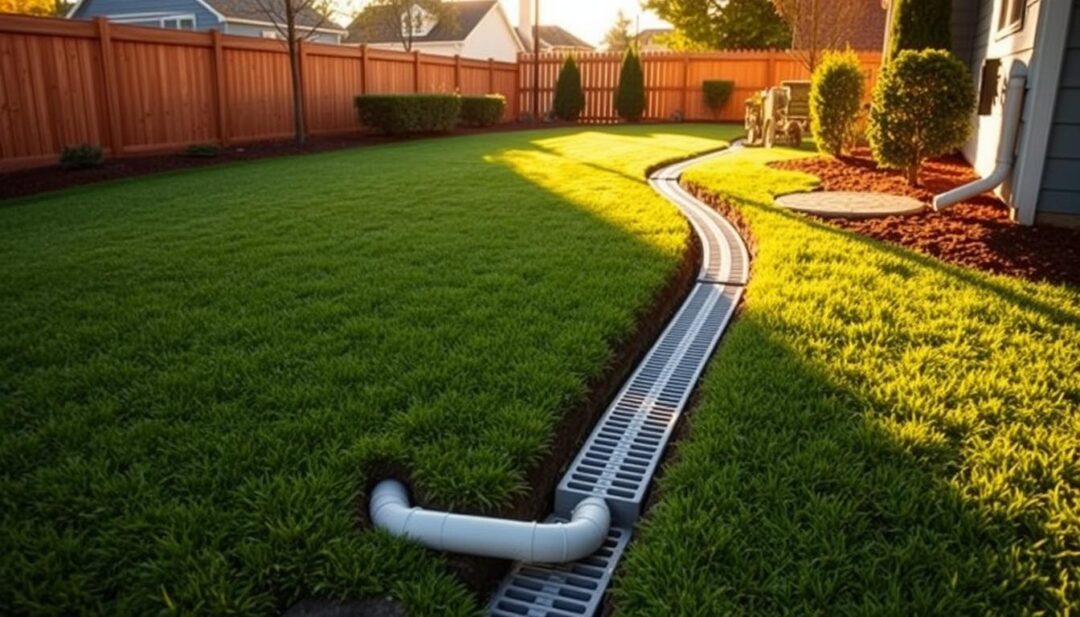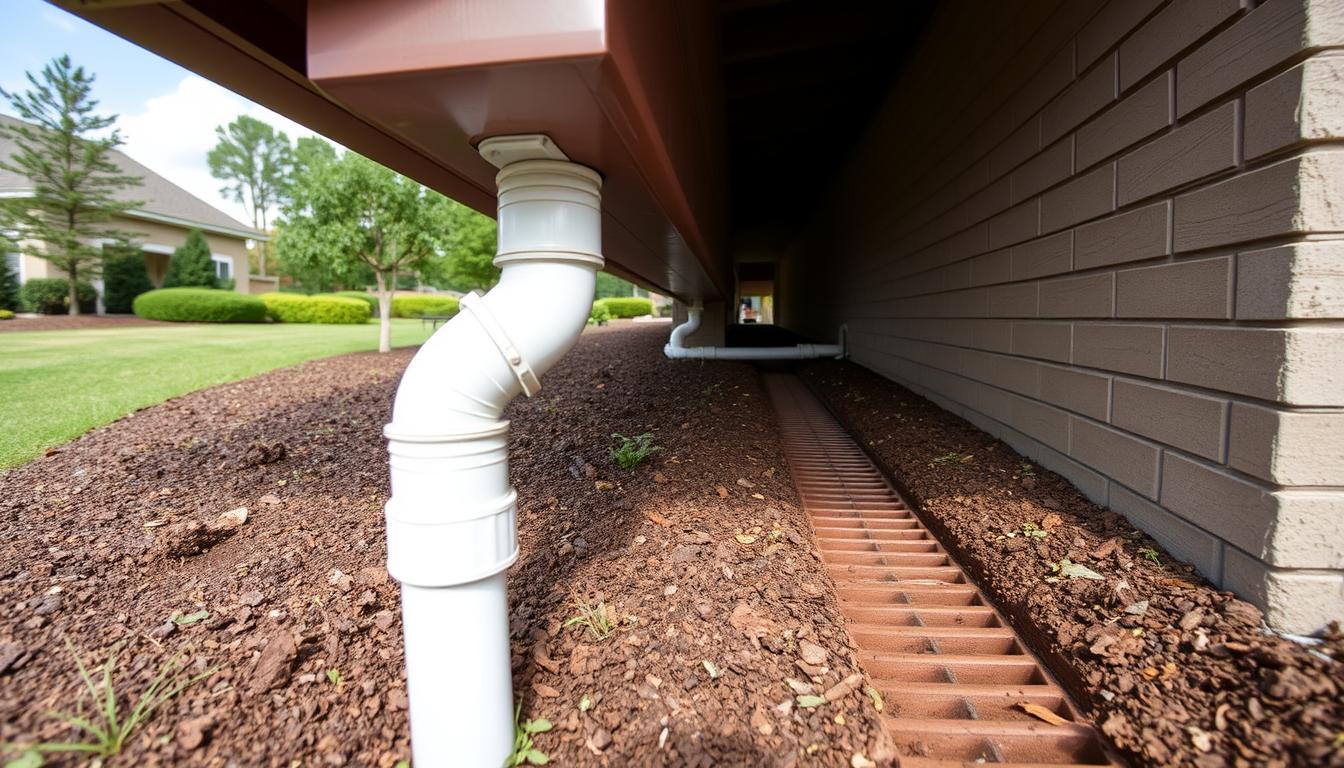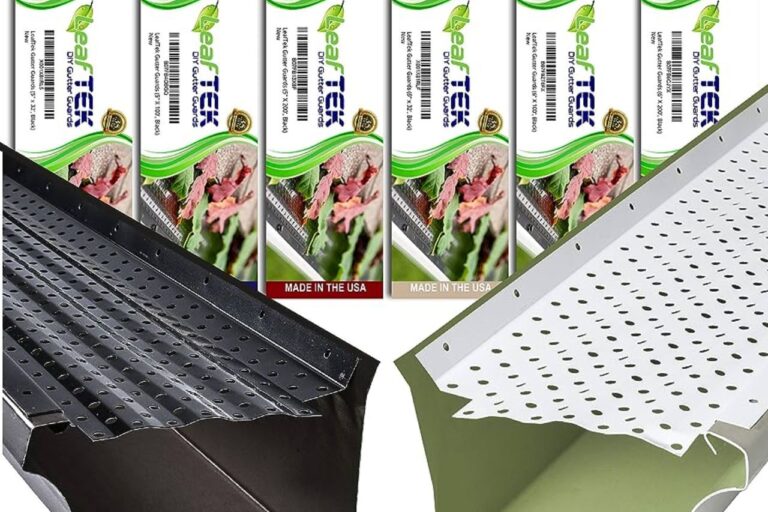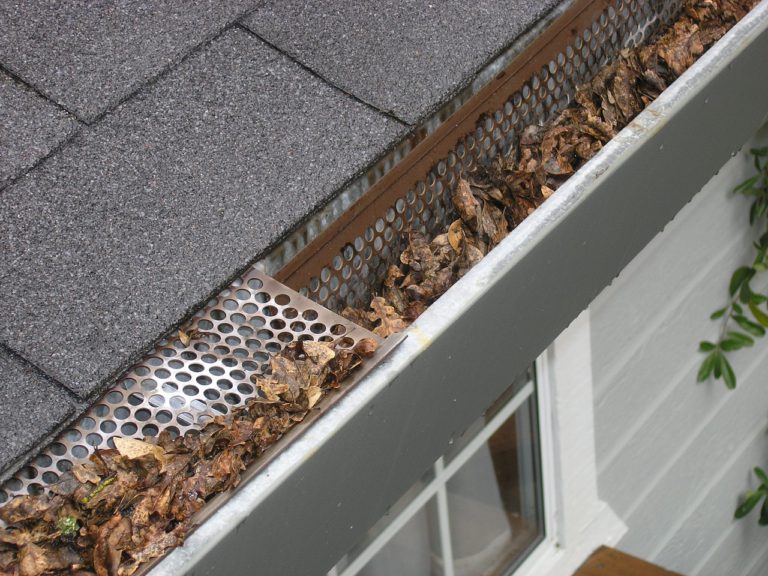Can You Tie Gutters Into a French Drain?
Are you wondering if integrating your gutter system with a French drain is the right solution for your home’s water management needs?
Many homeowners face issues with water accumulation around their properties, leading to damage and potential safety hazards. Effective drainage is crucial to preventing such problems.
Integrating gutters with a French drain can be a highly effective way to manage water runoff. This approach can help redirect water away from your home’s foundation, reducing the risk of damage.
Key Takeaways
- Efficient water management through gutter and French drain integration
- Reduced risk of water damage to your home’s foundation
- Improved overall drainage system performance
- Potential cost savings through reduced maintenance needs
- Enhanced property protection against water-related issues
Understanding French Drains and Gutter Systems
A well-designed drainage system is essential for protecting a home from water damage. To achieve this, it’s crucial to understand the components of such a system, particularly French drains and gutter systems.
What Is a French Drain?
A French drain is a trench filled with gravel and a perforated pipe that redirects water away from a specific area. It’s an effective solution for managing water accumulation around foundations, basements, or crawlspaces. The system works by allowing water to flow into the pipe, which then carries it to a more suitable location, thus preventing water damage.
How Traditional Gutter Systems Work
Traditional gutter systems are designed to collect rainwater from the roof and direct it away from the home’s foundation through downspouts. While they are effective in managing roof runoff, they don’t always address the issue of water accumulation around the foundation. Properly functioning gutters are crucial, but they are just one part of a comprehensive water management strategy.
The Problem of Water Management Around Foundations
Water accumulation around a home’s foundation can lead to significant structural issues, including cracks, leaks, and even foundation failure. Poor water management can result in costly repairs. Combining gutter systems with French drains can offer a seamless gutter to french drain connection, enhancing overall water management efficiency.
Some key benefits of integrating these systems include:
- Improved water drainage efficiency
- Enhanced foundation protection
- Better landscape preservation
By understanding how French drains and gutter systems work, homeowners can make informed decisions about their water management needs, potentially saving on future repair costs.
Benefits of Connecting Gutters to French Drains
Integrating gutters with French drains can significantly enhance your home’s water management system. This integration offers several key benefits that can protect your property and improve its overall drainage.
Improved Water Drainage Efficiency
By tying gutters and French drain systems together, you can efficiently direct water away from your home’s foundation. This combined system ensures that rainwater is quickly and effectively drained, reducing the risk of accumulation around your property.
Foundation Protection Benefits
Blending gutters into French drain systems helps safeguard your home’s foundation by preventing water from seeping into the soil nearby. This protection is crucial in preventing structural damage and costly repairs down the line.
Landscape Preservation Advantages
A well-integrated gutter and French drain system also helps preserve your landscape by preventing erosion and waterlogged areas. This keeps your outdoor spaces looking their best and reduces the need for frequent landscaping repairs.
Long-term Cost Savings
Uniting gutter and French drain systems can lead to significant long-term savings. By reducing the risk of water damage and associated repair costs, homeowners can enjoy financial benefits while maintaining their property’s integrity.
Can You Tie Gutters Into a French Drain?
Homeowners often wonder if it’s feasible to connect their gutter systems directly to French drains. This integration can be an effective way to manage water runoff, but it’s crucial to understand the technical feasibility and potential implications.
Technical Feasibility Analysis
Tying gutters into a French drain is technically possible, but it requires careful planning and execution. The key is to ensure that the downspout pipes are properly connected to the French drain system without causing clogs or system failures. According to experts, directly tying downspout pipes to French drain pipes is not recommended due to the risk of clogs and system failures.
When Integration Makes Sense
Integration makes sense in areas with heavy rainfall or where water tends to accumulate around the foundation of a house. By connecting gutters to French drains, homeowners can improve water drainage efficiency and protect their foundations.
Potential Drawbacks to Consider
While integrating gutters with French drains can be beneficial, there are potential drawbacks to consider. These include increased installation complexity, potential for clogs, and the need for regular maintenance to ensure the system functions properly.
Success Factors for Integration
For successful integration, several factors must be considered. These include proper sizing of the French drain, correct installation of the gutter downspout connections, and regular maintenance of the entire system. By paying attention to these factors, homeowners can enjoy the benefits of improved water management.
By understanding the technical feasibility, benefits, and potential drawbacks, homeowners can make informed decisions about integrating their gutter systems with French drains. This can lead to more effective water management and protection of their properties.
Planning Your Integrated Drainage System
To successfully connect gutters to a French drain, homeowners must first understand their property’s drainage needs. This understanding forms the foundation of a well-designed integrated drainage system.
Assessing Your Property’s Drainage Needs
Assessing your property’s drainage needs involves evaluating the slope of your land, the amount of rainfall your area receives, and the existing drainage infrastructure. Key areas to inspect include:
- The slope and grading of your yard
- The condition and capacity of your existing gutters and downspouts
- Any areas where water tends to accumulate or flow
Calculating Water Volume from Roof Runoff
Calculating the volume of water that flows off your roof during rainfall is crucial for sizing your French drain correctly. This involves measuring your roof’s surface area and considering the average rainfall intensity in your area. A simple formula to estimate roof runoff is: Roof Area x Rainfall Intensity x Runoff Coefficient.
Mapping the Optimal French Drain Location
Mapping the optimal location for your French drain requires identifying the path of least resistance for water flow and ensuring that the drain is positioned to effectively capture and redirect water away from your foundation. Consider:
- Plotting the most direct route for the French drain
- Avoiding obstacles like trees, septic systems, and other underground structures
- Ensuring the drain terminates at a suitable outlet, such as a storm drain or a natural watercourse
Creating a Connection Strategy

Creating a connection strategy between your gutters and French drain involves deciding on the type of downspout adapters to use, the routing of the connecting pipes, and how to maintain a smooth flow of water through the system.
By carefully planning each of these aspects, homeowners can create an integrated drainage system that effectively manages water runoff, protects their foundation, and enhances their property’s overall drainage efficiency.
Materials and Tools Needed for Integration
To achieve an efficient tying gutters and French drain setup, it’s essential to understand the necessary components and tools. The integration of gutters with French drains requires careful planning and the right materials to ensure a seamless gutter to French drain connection.
Pipe Types and Sizes
The choice of pipe is critical for the French drain system. Typically, a perforated pipe is used to allow water to enter and flow through the system. The size of the pipe depends on the expected water volume; larger roofs require larger diameter pipes to handle the increased runoff. Popular options include corrugated plastic pipes, which are durable and resistant to corrosion.
Connectors and Adapters
To unite gutter and French drain systems effectively, the right connectors and adapters are necessary. These components ensure that downspouts are securely attached to the French drain pipe, preventing leaks and maintaining the system’s integrity. Flexible adapters can be particularly useful in navigating around obstacles.
Gravel and Fabric Requirements
Gravel surrounds the French drain pipe, facilitating water flow into the pipe while filtering out sediment. The fabric, typically a landscape fabric, wraps around the gravel and pipe to prevent clogging by soil and roots. Both materials are crucial for the long-term functionality of the French drain.
Essential Tools for Installation
Key tools for the installation include a trench digger or backhoe for excavating the drain path, pipe cutters for sizing the pipes correctly, and a level to ensure the trench slopes correctly for optimal water flow. Having the right tools on hand simplifies the process and improves the outcome of the uniting gutter and French drain project.
Step-by-Step Guide to Connecting Gutters to French Drains
Integrating your gutter system with a French drain can significantly improve water drainage efficiency around your property. This step-by-step guide will walk you through the process of connecting your gutters to a French drain, ensuring a well-designed and functional water management system.
Preparing the Downspout Connection
The first step in joining your gutter and French drain systems is to prepare the downspout connection. This involves attaching a downspout adapter to the bottom of your downspout. The adapter should be sized appropriately to fit your downspout and the pipe that will connect to the French drain.
Ensure the adapter is securely attached to prevent any leaks or disconnections during heavy rainfall. You may need to use additional hardware such as screws or clips to secure the adapter in place.
Digging the Trench System
Once the downspout connection is prepared, the next step is to dig a trench for the French drain system. The trench should be dug at a slight slope to allow water to flow freely towards the desired drainage area.
The depth and width of the trench will depend on your specific needs, but typically, it should be deep enough to accommodate the French drain pipe and surrounding gravel.
Installing the French Drain Components
With the trench dug, you can begin installing the French drain components. This includes laying down a layer of gravel at the bottom of the trench, followed by the French drain pipe, and then covering it with more gravel.
The French drain pipe should be perforated to allow water to enter and should be wrapped in a fabric sleeve to prevent clogging from sediment.
Creating the Gutter-to-Drain Connection
After installing the French drain components, you need to create the connection between your gutter downspout and the French drain. This involves running a pipe from the downspout adapter to the French drain, ensuring a secure and watertight connection.
You may need to use additional fittings such as elbows or couplers to navigate around obstacles and achieve a smooth connection.
Testing the System
Finally, it’s crucial to test your integrated gutter and French drain system to ensure it’s working correctly. Run water through the gutters and check that it flows properly through the downspout, into the connecting pipe, and finally into the French drain.
Inspect the system for any leaks or blockages, making adjustments as necessary to ensure optimal performance.
| Step | Description | Key Components |
|---|---|---|
| 1 | Preparing the Downspout Connection | Downspout adapter, screws or clips |
| 2 | Digging the Trench System | Trenching tool, gravel |
| 3 | Installing the French Drain Components | French drain pipe, gravel, fabric sleeve |
| 4 | Creating the Gutter-to-Drain Connection | Connecting pipe, elbows, couplers |
| 5 | Testing the System | Water, inspection tools |
DIY vs. Professional Installation Considerations
When considering integrating your gutters with a French drain, one of the primary decisions you’ll face is whether to tackle the project yourself or hire a professional. This decision hinges on several factors, including your DIY experience, the complexity of the installation, and your budget.
When to Tackle the Project Yourself
If you have experience with DIY projects, particularly those involving plumbing or drainage systems, you might be well-equipped to handle the integration of your gutters with a French drain. This approach can save you money on labor costs and give you a sense of accomplishment. However, it’s crucial to assess whether you have the necessary tools and knowledge to complete the job correctly.
When to Call in the Professionals
For more complex installations or if you’re unsure about any aspect of the process, it’s wise to hire professionals. Experts can ensure that the job is done efficiently and correctly, potentially saving you from costly repairs down the line due to improper installation. They can also provide valuable insights into the best materials and designs for your specific situation.
Cost Comparison of DIY vs. Professional Work
The cost is a significant factor when deciding between DIY and professional installation. While DIY can save on labor costs, purchasing the necessary materials and tools can add up. Professional installations come with labor costs, but they often have access to better prices on materials due to their industry connections.
| Installation Type | Cost Factors | Average Cost |
|---|---|---|
| DIY | Materials, Tools | $500-$1,500 |
| Professional | Labor, Materials | $1,500-$3,500 |
Timeline Expectations for Both Approaches
The timeline for completing the project varies significantly between DIY and professional installations. DIY projects can take anywhere from a few days to several weeks, depending on your availability and the project’s complexity. Professional installations are typically faster, often completed within a few days, as the work is being done by experienced individuals working full-time on your project.
Ultimately, the decision between DIY and professional installation for integrating gutters with a French drain should be based on your specific circumstances, including your skills, budget, and the project’s complexity.
Common Challenges and Troubleshooting
The integration of gutters and French drains, while beneficial, presents a unique set of challenges for homeowners and installers alike. A well-designed system requires careful planning and execution to overcome potential issues.
Dealing with Elevation Issues
One of the primary challenges is ensuring that the French drain is installed at a suitable elevation to effectively collect and redirect water. Proper grading is essential to prevent water from accumulating around the foundation.
Preventing Clogs and Blockages
Clogs and blockages are common issues in combined gutter and French drain systems. Regular maintenance, including cleaning gutters and downspouts, is crucial to prevent debris buildup.
| Maintenance Task | Frequency | Benefits |
|---|---|---|
| Gutter Cleaning | Twice a Year | Prevents Clogs, Ensures Water Flow |
| Downspout Inspection | After Heavy Rainfall | Identifies Blockages Early |
| French Drain Check | Annually | Ensures Proper Water Redirection |
Addressing Freezing Concerns in Cold Climates
In colder climates, freezing temperatures can cause issues with water flow. Using freeze-resistant materials and ensuring that the system is designed to handle ice formation can mitigate these problems.

Solving Connection Leaks
Leaks at the connection points between gutters and French drains can compromise the system’s effectiveness. Using proper connectors and adapters and ensuring tight seals can prevent leaks.
By understanding and addressing these common challenges, homeowners can ensure that their integrated gutter and French drain system functions optimally, providing effective water management and protection for their property.
Alternative Drainage Solutions Compared
While French drains are a popular choice for managing water runoff, other drainage solutions might better suit specific property needs. Homeowners have various options to consider when looking to protect their properties from water damage.
Dry Wells and Rain Barrels
Dry wells and rain barrels are effective alternatives for managing roof runoff. Dry wells are underground structures that collect and dissipate water, while rain barrels store water for later use, reducing the burden on drainage systems.
Surface Drainage Options
Surface drainage solutions, such as swales and grading adjustments, can redirect water flow away from structures. These methods are often less invasive and can be aesthetically pleasing.
Rain Gardens and Bioswales
Rain gardens and bioswales are landscaped features that absorb and filter rainwater, reducing runoff and improving water quality. They can be integrated into existing landscapes to enhance both functionality and beauty.
When Alternatives Might Be Better Than French Drains
Alternatives to French drains may be more suitable depending on the property’s specific conditions, such as soil type, slope, and local regulations. A comparative analysis can help determine the best solution.
| Drainage Solution | Effectiveness | Cost |
|---|---|---|
| Dry Wells | High | Moderate |
| Rain Barrels | Moderate | Low |
| Rain Gardens | High | High |
By considering these alternative drainage solutions and their characteristics, homeowners can make informed decisions about the best way to manage water around their properties, potentially integrating these solutions with their gutter systems for enhanced effectiveness.
Conclusion
Tying gutters into a French drain can be an effective way to manage water runoff and protect your property’s foundation. By understanding the benefits and challenges of integrating gutters with French drains, homeowners can make informed decisions about their drainage needs.
A seamless gutter to french drain connection can improve water drainage efficiency, reduce the risk of foundation damage, and preserve the landscape. However, it’s essential to consider the technical feasibility, potential drawbacks, and success factors for integration.
When done correctly, integrating gutters with French drains can provide long-term cost savings and peace of mind. By assessing your property’s drainage needs, calculating water volume from roof runoff, and mapping the optimal French drain location, you can create a comprehensive drainage solution.
Whether you choose to tackle the project yourself or hire a professional, understanding the process and potential challenges will help you achieve a successful outcome. By integrating gutters with French drains, you can ensure a can you tie gutters into french drain system that effectively manages water runoff and protects your property.



